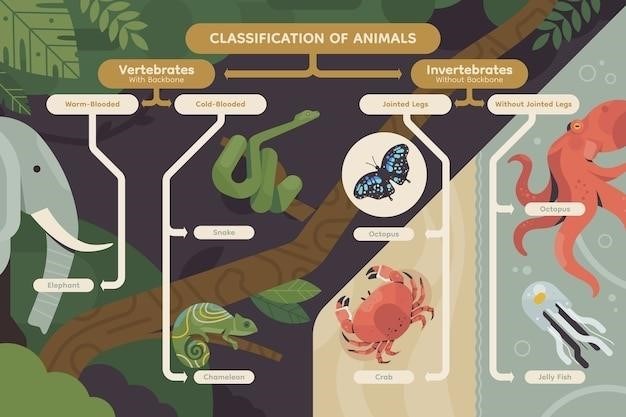Animal Physiology 5th Edition⁚ An Overview
This comprehensive textbook, authored by Richard Hill, provides a current and engaging exploration of animal physiology. Its authoritative content and lavish illustrations make it a trusted resource for students and instructors alike.
Authors and Publication Details
Animal Physiology, 5th Edition boasts a distinguished authorship team. Richard W. Hill, a prominent figure in the field, leads the team, bringing his extensive expertise and experience to the forefront. He is joined by Margaret Anderson, Emerita of Smith College, and Daniel Cavanaugh, whose contributions significantly enhance the book’s scope and depth. Published by Sinauer Associates, an imprint of Oxford University Press, the 5th edition arrived on November 30, 2021. This edition is presented in English and features a hardcover format, encompassing a substantial 992 pages of detailed information and high-quality illustrations. The collaborative effort of these authors results in a text that is both comprehensive and accessible, ensuring a rich learning experience for students.
Key Features and Strengths
Hill’s Animal Physiology, 5th Edition distinguishes itself through several key features. Its authoritative and up-to-date content ensures students receive the most current information in the field. The engaging presentation style keeps students actively involved in the learning process, fostering a deeper understanding of complex physiological concepts. Lavishly illustrated with clear and detailed diagrams, the book enhances comprehension and retention. The text’s strength lies in its ability to integrate evolutionary and ecological perspectives, enabling students to grasp the broader context of animal physiology and appreciate its connections across various levels of biological organization. This integrated approach is a significant advantage, bridging the gap between theoretical knowledge and real-world applications. The comprehensive nature of the text, coupled with its accessible writing style, makes it an ideal resource for students of all backgrounds and learning styles.
Content Coverage and Structure
The fifth edition of Hill’s Animal Physiology offers a comprehensive exploration of animal physiological mechanisms. The book’s structure is logically organized, guiding students through fundamental principles and progressively delving into more specialized topics. It covers a wide range of subjects, encompassing cellular and molecular mechanisms, organ system function, and whole-animal physiology. The text effectively integrates various levels of biological organization, allowing students to understand the interconnectedness of different physiological processes. Each chapter is thoughtfully structured with clear learning objectives, concise explanations, and engaging examples to illustrate key concepts. Furthermore, the inclusion of evolutionary and ecological contexts within each chapter helps students connect physiological adaptations to environmental pressures and evolutionary history. This detailed and systematic approach ensures a thorough understanding of animal physiology’s intricacies.
Access and Availability of the PDF
Direct PDF access isn’t officially provided by the publisher. However, used copies and potential alternative sources may exist online. Proceed with caution regarding copyright.
Online Retailers and Platforms
While a direct PDF download for “Animal Physiology, 5th Edition” by Richard Hill isn’t typically offered by the publisher, various online retailers and platforms may offer used or new physical copies of the textbook. Sites such as Amazon, eBay, and other online bookstores often list used textbooks at discounted prices, providing a potential avenue for acquiring a physical copy. Additionally, some platforms specializing in academic materials may offer digital versions, although the legality and authenticity of these sources should be carefully verified. Always ensure you are purchasing from reputable sellers to avoid counterfeit or unauthorized copies. Remember to check reviews and seller ratings before making a purchase to ensure you receive a legitimate and usable textbook.
Alternative Sources and Libraries
If purchasing the textbook isn’t feasible, exploring alternative avenues for accessing the material is recommended. Many university and college libraries subscribe to online databases containing textbooks, including potentially “Animal Physiology, 5th Edition.” Check your local library system’s online catalog or contact a librarian to determine availability. Interlibrary loan services may also allow you to borrow a copy from another institution’s library. Additionally, some open educational resource (OER) platforms or websites might offer similar content under a Creative Commons license. Remember to always respect copyright laws and only access materials legally available through your institution or authorized online sources. Exploring these avenues can offer free or low-cost access to the information needed for your studies.
Copyright and Legal Considerations
Accessing copyrighted material requires adherence to copyright law. Downloading or sharing “Animal Physiology, 5th Edition” PDFs from unauthorized sources is illegal. Publishers hold exclusive rights to their works, and unauthorized distribution infringes upon these rights. Respecting copyright protects authors and publishers, ensuring they receive compensation for their work. Legitimate access routes, such as purchasing the textbook or utilizing library resources, are crucial. Pirated copies often lack quality control and may contain errors. Academic integrity is paramount; using unauthorized materials can lead to serious consequences for students, including failing grades or expulsion. Always obtain the textbook through legitimate channels to support authors and maintain ethical academic practices. Remember that respecting intellectual property is essential for a healthy academic environment.

Pedagogical Features and Resources
The 5th edition boasts enhanced e-books with section quizzes and self-assessments, supplemented by instructor resources and a comprehensive test bank.
Instructor Resources
Instructors utilizing the Animal Physiology, 5th Edition benefit from a robust suite of supplementary materials designed to enhance teaching effectiveness and student engagement. These resources are specifically curated to address common challenges faced in animal physiology instruction, providing valuable tools for both in-class delivery and assessment. A comprehensive test bank offers a wide range of questions, allowing instructors to create customized assessments tailored to their specific course objectives and student needs. This ensures a thorough evaluation of student understanding and identifies areas requiring further attention or clarification. Furthermore, readily available in-class lecture resources streamline the preparation process, freeing up valuable time for instructors to focus on other essential aspects of their teaching responsibilities. The availability of these resources ensures that instructors can efficiently deliver high-quality instruction, fostering a deeper understanding of animal physiology principles among their students. This holistic approach to teaching materials contributes to a richer and more engaging learning experience. The combination of assessment tools and lecture support creates a comprehensive and well-rounded learning environment; The thoughtfully designed resources address the key issues faced by instructors in conveying complex concepts effectively and facilitating a thorough understanding of the material.
Student Resources
Accompanying the Animal Physiology, 5th Edition textbook is a rich collection of student resources designed to enhance comprehension and promote active learning. A key component is the enhanced e-book, providing convenient access to the textbook content. Beyond simple access, this e-book integrates interactive elements, transforming passive reading into an active engagement with the material. Self-assessment quizzes allow students to test their understanding of key concepts, providing immediate feedback and identifying areas needing further study. These quizzes serve as valuable tools for self-directed learning, allowing students to monitor their progress and reinforce their learning. Section quizzes further break down the material into manageable chunks, focusing on specific learning objectives. This structured approach promotes a deeper, more nuanced understanding of animal physiology. The combination of readily available, interactive tools and focused assessments fosters a more effective and engaging learning experience for students. This tailored support system ensures that students have the resources they need to succeed in their animal physiology studies. The user-friendly design of these resources makes them accessible and encourages active participation in the learning process.
Interactive Elements and Assessments
The Animal Physiology, 5th Edition by Richard Hill incorporates a variety of interactive elements and assessments to enhance the learning experience. These features move beyond passive reading, encouraging active engagement with the material. Interactive layered figures allow students to explore complex physiological processes in a dynamic way, building a deeper understanding through visual exploration. The interactive elements are seamlessly integrated within the online resources, providing a user-friendly experience. Self-assessment quizzes, accessible through the enhanced e-book, provide immediate feedback, helping students track their progress and identify areas requiring further attention. These quizzes aren’t merely tests; they are learning tools, offering opportunities for reinforcement and clarification. The inclusion of these interactive elements and regular assessments promotes a more effective and engaging learning process, allowing students to actively participate in constructing their knowledge of animal physiology. This interactive approach caters to diverse learning styles, maximizing comprehension and retention. This blend of active learning strategies elevates the textbook from a passive source of information to an active tool for understanding complex biological processes.

Content Highlights and Updates
The 5th edition offers a contemporary and engaging approach, incorporating evolutionary and ecological contexts to enhance understanding across physiological scales;
Changes from Previous Editions
While specific details on changes from prior editions aren’t explicitly listed in the provided text excerpts, the emphasis on the 5th edition being “revised and updated,” and “comprehensive, contemporary, and engaging” strongly suggests substantial alterations. These likely include updated research findings, refined pedagogical approaches, and potentially restructured content to better integrate evolutionary and ecological perspectives. The inclusion of enhanced digital resources, such as interactive layered figures and a comprehensive test bank, points to significant improvements in the supplementary materials. The increased page count in some listed editions (from 874 to 992 to 1018 pages) further indicates a substantial expansion or revision of the core content. The consistent praise for its authoritative and engaging presentation hints at improvements in clarity, accessibility, and the overall learning experience. Therefore, the fifth edition represents a noteworthy enhancement over its predecessors, offering students and instructors a more current and effective learning tool.
Evolutionary and Ecological Context
A key strength highlighted for Hill’s Animal Physiology, 5th edition, is its integration of evolutionary and ecological principles. The text doesn’t just present physiological mechanisms in isolation; instead, it emphasizes how these mechanisms have evolved and how they function within specific ecological contexts. This approach helps students understand the “why” behind physiological adaptations, connecting the micro-level processes of cells and tissues to the macro-level challenges faced by animals in their environments. By examining the evolutionary history and ecological pressures shaping physiological traits, students gain a deeper appreciation for the diversity and complexity of animal life. This integrated perspective promotes a more holistic understanding, moving beyond rote memorization to a richer, more meaningful comprehension of the subject matter; The book’s success is partly attributed to this successful incorporation of evolutionary and ecological contexts throughout its content, making it a valuable resource for students seeking a comprehensive and insightful exploration of animal physiology.
Leave a Reply
You must be logged in to post a comment.